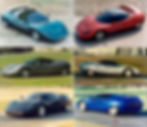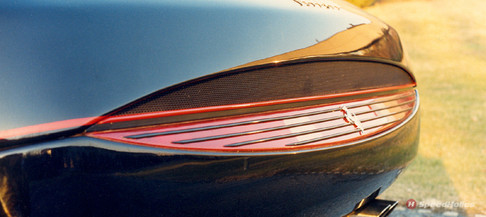Ferrari F90: Enrico Fumia reveals the “Sultan’s Secret”
- Alberto Amedeo Isidoro
- Nov 1, 2021
- 11 min read
Updated: Dec 28, 2021
A rather incredible story that began in 1988 following a special request from Prince Jefri, the brother of the Sultan of Brunei, Hassanal Bolkiah, a fervent car collector, to whom it would have been impossible to say no: a top-secret mission to build an exclusive supercar, based on the chassis of the Ferrari Testarossa but with a completely unique design. Enrico Fumia, the designer behind the lines and the concept, told SpeedHolics how Pininfarina built six cars, unbeknown to Maranello.
Photos courtesy of Enrico Fumia Archive

There is a very tiny space in the car world in which cars are half-way between dream and reality. This is mostly a place in the mind, but sometimes, if we are curious and lucky enough, we may have a chance to pass by this space and take a look. In this small, unspoiled part of the car world, where the fresh winds that blow are so wondrously far from the rules and conventions governing common sense, we may find the human imagination acting alone, in a revolution that seeks to combine innovation and creativity.
“Innovation not just renovation” is the mantra that has always marked Enrico Fumia's way of designing and understanding life.
From Turin, a degree in aeronautical engineering and a long-standing career as manager and designer, a free thinker and free spirit, after a very long career in Pininfarina and Lancia - where he shaped some of the very successful models including the Alfa Romeo 164 (1987), Spider and GTV (1994), Lancia Y (1995) - he went freelance, firstly at Master Design Intl., then Fumia Design Associati and Fumia Design Studio (designing cars and more for Japan and China), at the age of 73, Fumia continues to feed off dreams and fantasy. He does not fear contradiction, indeed he believes it to be a blessing: “To the Contrary Mary in me”, recites the dedication on the cover of a copy, by mistake bound on the wrong side, of “AUTOritratto”, the autobiography published by Fucina Editore in which, using brushstrokes that are at times unexpected and often fierce, with no fear of going beyond the canvas, he tells of a life of ideas and projects “outside the box”.
We met him to talk about one of his most important (and yet least famous) projects, in his cosy house in the Piedmont hills of San Matteo, a stone’s throw from Bra, the city of sausages, cheese and good wine.
The story of the Ferrari F90, closer to an adventure novel than the tale of a supercar, began over a delicious ‘moka’ coffee prepared by his wife Kazuko, who is 100% Japanese but, next to Enrico, has learned all the lightest and brightest arts of Italian living.

Let’s start from the beginning. How was the Ferrari F90 born?
From a specific request of Prince Jefri, the brother of the Sultan of Brunei, Hassanal Bolkiah, a fervent collector of cars, all the better if tailor-made. Having commissioned twelve Testarossa-turned spiders from Pininfarina, in 1988, through the then-Ferrari importer in Singapore, he asked us to build an exclusive, top-secret supercar, based on the Testarossa chassis but with a completely unique design.
What do you mean by top secret?
The importer explained to us that, if we accepted, nobody was to know about it, especially not Ferrari. There and then, this was quite a shock, as Pininfarina would have had to hide the project from Maranello and the manufacturers they were closely tied to.

But in the end, you agreed.
In economic terms it was very enticing. We couldn’t say no, both for the amount and the advance payment for the first and then the following cars; because the idea was that if he liked the first F90, he would have ordered others. And in fact, the order went from one to six. Which made the prince our top customer in terms of turnover, it was more profitable than any other manufacturer we worked with. That’s why we couldn’t say no.
And at that point, how did you decide to proceed?
We had almost finished the Mythos, which was still called the P7 in Pininfarina code, chosen as the show car for the Tokyo salon in 1989 and so not unique, but Prince Jefri demanded that the car had to be made starting from scratch. But faced with this specific request, there was someone - not me - who preferred to offer the prince some of the designs that had been rejected before the Mythos was chosen.

And among the many sketches was yours. Did you run a kind of in-house contest to decide the winner? No, as usual in these circumstances we sent the pack of drawings (the ones recycled from the Mythos project) with a range of proposals to the prince. And according to his own taste, he chose mine. He then confirmed this decision after seeing a 1:5 scale model first-hand.
At that time, you were deputy general director at Pininfarina. How did you find the time to sit down and draw? At work I had very little time to sit down and put the ideas running through my mind onto paper. So I drew in my spare time: even - though not mostly - at home, but only when I was inspired or particularly interested in the project. And in this I realise that I was very lucky. Then, I must say that at work, anyone who could hold a pencil, even the gatekeeper (no offence!) could draw something and present it to the style department. Everything was hung on the wall, and nothing was ever rejected a priori.



And now, the name: why the F90? Easy: it was an acronym of Ferrari for the 90s, which were almost there. So, something imagined as the forefather of a new generation of “Cavallino” cars for the coming decade.
And talking of inspiration: is there a creative link between the past and future of the Prancing Horse in the forms of the F90, which was extremely pioneering compared to the Ferraris of the time?
Looking at the models that came before, I would say yes. For those that came after, absolutely not; if not for one detail: the headlights. But only for some. Having to design a Ferrari-Pininfarina, I knew that I would have to respect two great traditions. This is why I built that which, in the style studies of a brand, I call Recognisability or Identity Cycle; this is a method I used, consisting of three steps: 1) reinterpretation of the Brand’s stylistic past; 2) selection of the consolidated stylistic features, even the forgotten ones; 3) historization, in other words the updating of the most significant stylistic features and the introduction of new ones, in line with the brand’s tradition. While the first two are academic, the third is based on the subjectivity of the designer: a play on words to say that the designer must be able to justify the new style codes introduced as ideally part of the Brand’s tradition. This is far from taken for granted. And this is why today, new stylistic features are as rare as great designers. It’s all dominated by stylistic imitations, bordering on caricatures, legends of the past, something I would define as examples of a creative void. I say this specially to spur on the new generation, forcing them to squeeze their brains and attempt new solutions, which can in turn become icons.
And you had already experimented this method?
I had applied it to the Alfa 164, Spider and GTV, but without stating it, because at that time - in contrast to today - taking inspiration from the past sounded like you didn’t have any new ideas. But seeing the objectively good results, I continued to use it, with some great satisfaction.
Going back to the F90, which style detail most inspired you looking back over the Ferrari tradition?
The one element that I updated so much as to make it a new stylistic feature of the Ferrari tradition is what I call the “pointed ellipse”. It is the reinterpretation of the elliptic front grille on the Superfast II, 365 and 330 in the 1960s, inspired by the “mouths” of the F1 cars of the time, including Ferrari. But I challenge anyone to notice at first glance without this explanation. Which means that the pointed ellipse grille became a modern innovation. We shouldn’t forget that the drawing of the F90 dates back to September 1988, so today is more than thirty years old. And as mentioned, in that drawing even the headlights were really innovative for the time, in both shape and technology. Looking only at the narrow and elongated shape, they are the update of those that we usually hidden beneath glass in the 1960s GT Ferraris. Then, moving on to the mid-2000s, those on the Enzo, 612 Scaglietti and F430 aren’t that much different.

The pointed ellipse motif is repeated on four sides: the two sides, the front and the rear. Something very similar can be seen on one of your greatest successes, the Lancia Y. How did the idea of that symmetry come about? The idea of repeating the same graphic motif on four sides of the bodywork, that I defined “quadrifrontal”, has always been used in architecture, especially in symbolic monuments: from the Egyptian pyramids to eastern pagodas, from the Eiffel Tower to the Mole Antonelliana. But not on four sides of a car. If anything on two: similar front and rear, like the Panhard PL15-17, Renault Dauphine, Simca 1000, Chevrolet Corvair, and even the first Audi TT. Four equal sides have the considerable advantage of ensuring instant recognisability of an object from any angle, which I think is very useful. This is where the idea of repeating the pointed ellipse of the grille also on the rear and the two sides came from. Not in the same proportions, but adapted to each function.
A style that is not an end in itself, but is always functional.
The grille is not fake like on the Testarossa, here it really carries air to the front radiator, built ex-novo to replace the two side ones on the Testarossa, on which the F90 is based. The elliptical casing on the side, on the other hand, includes other air intakes and the door handle; while at the rear, half contains the lights and the rest is the air grille, to dissipate the residual heat from the engine. As for the comparison with the Y, only I knew, and had the professional honesty, to remark in my book on the analogy of the quadrifrontal of the first style model of the Y with a “Stop & Go!”. Otherwise, nobody would have ever noticed it, as the F90, unknown at the time, is recognisable to most people even today. With this, we can't say that the Lancia Y looks like a little Ferrari, nor the F90 like a hyper-Lancia. I swear that if the F90 ever appeared in public, almost certainly I would not have transferred it onto the Y. So, it’s fate was sealed. And I would add that if they had both been on the market, well... Giugiaro’s first Lancia Delta is pretty much the transposition of his Audi concept-car Asso di Picche. And nobody cried foul, far from it.

The twelve Testarossa Spiders for Prince Jefri were tested directly by Ferrari, while the F90 had to keep its distance from Maranello. How were the tests organised?
We tested mostly at night, without the Prancing Horse emblem and with the bodywork completely camouflaged to make it unrecognisable. I took part in the tests sometimes, and, as the car was a right-hand drive, when I drove someone else had to sit in the passenger seat to pay the tolls at the motorway exits. For instance, I remember the engineer Renzo Trivero, who unfortunately died prematurely. Not only was he a 100% engineer, he was also an excellent driver. After my traumatic departure from Pininfarina in late ‘92, he was the one who developed the last three units of the six built and still in Brunei today, who knows in what condition.

But at one point, the secret got out.
Yes, it was all the fault of the web! One day in 2002, in one of the very first car scoops appearing on the web, a photo was published showing a red F90 in one of the garages where the prince kept part of his collection of - so they say - over 7,000 cars.
How did Ferrari react? In total silence for quite a while. Then, in 2005, Roberto Bonetto, the then-deputy editor of the historical Italian magazine Quattroruote, phoned me to find out the true story of the F90 and ask if he could put a photo of the car in the Extravaganza section of the Ferrari annual. In fact, Quattroruotine, a model-building magazine which no longer exists today, had already published the pictures of a 1:43 scale model that ABC Brianza had made 300 of, simply called the F90 Sultan. Which meant that neither the name Ferrari nor any Prancing Horse symbols appeared. This time the situation was much more delicate, so I told Bonetto that I would like to talk it through with Maranello. And that’s what I did, I went to see Antonio Ghini, the then-communications manager at Ferrari.
Did you tell him everything?
From start to finish. I told him about the photos that had appeared on the web, about the Sultan and all the rest.
And how did he react?
Better that we could ever have expected, in fact, after consenting to the publication of the photos in the 2005 annual, which the clients would have received in 2006, Ferrari officially recognised the F90 as an authentic Ferrari, without ever having seen or touched it. And of course, as the father of the design, I was over the moon.


And today, what do we know of the F90s? I often wonder that too. As far as I know they're all still in Brunei, even though we have no idea in what condition. I’m still in contact with the prince’s intermediary, and I asked him why, at one point, the relations with Pininfarina stopped. From what I understood, his brothers, tired of his whims, wouldn’t put up with his crazy car spending anymore.
The prince must be quite an extravagant one.
I don’t know, nobody ever had any direct contact with him. I for one owe him a lot, because he was the only real patron I came across in my life. I consider him much more than a sponsor, as he trusted me and the Pininfarina style and its skilled workers, without ever interfering or demanding anything, despite paying handsomely for the objects of his desires.
Did you never think to send him a letter? No, but I will do soon, with a copy of my book. But I’m superstitious, and would rather not talk of that right now. What I can say is that I will thank him for choosing the F90 and that I still have two dreams to make come true… if he wants, and if he can, I hope.
OK we can respect your superstitions, but do tell us something more… I don’t know what I would give today to see at least one of the six F90s again and be able to show it off in public at last. Even for just one day. Then, I would tell him about the concept F1o2, a supercar with a rotating mechanism that can create a single-seater or two-seater layout, that I began to work on in October 2000, when Schumacher was about to win his first Formula 1 world championship with the Ferrari after more than 20 years, as a homage to Ferrari’s new-found supremacy. I proposed it to Maranello, talking to Amedeo Felisa, ex-General Director and in more recent times the CEO of Ferrari, for 5 years. Although he was very interested - they even successfully tested the mechanism in the passenger compartment of the Enzo -, in the end nothing came of it.

We can see from Fumia’s face how disappointed he still is about this missed opportunity. “I still have that healthy professional arrogance to consider the F1o2 an authentic piece of Made in Italy,” he says as he takes a white-painted 1:10 scale model from a cupboard in his office. He opens the doors, slides out the steering wheel and shows us the mechanism that, in just a few simple steps, turns the car into a single-seater or a two-seater. Not a three-seater. Who knows what Prince Jefri would think of it. “Good question,” Fumia replies. If he likes it, he knows where to find me. But first I have to pull my finger out and send him that letter…”.








































